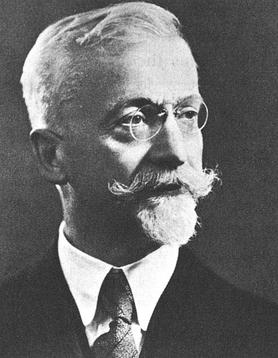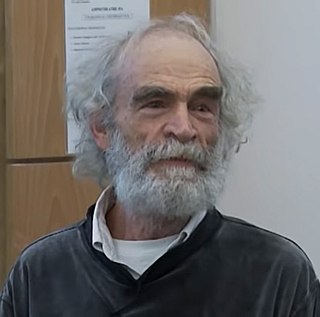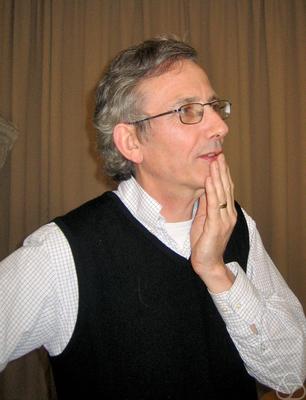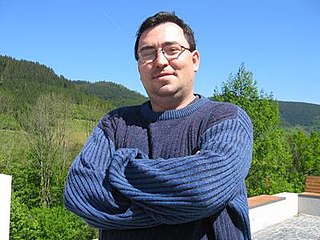Shlomo Sternberg | |
|---|---|
| Born | November 20, 1936 |
| Alma mater | Johns Hopkins University |
| Awards | Guggenheim Fellowship, 1974 |
| Scientific career | |
| Fields | Mathematics |
| Institutions | Harvard University New York University University of Chicago |
| Thesis | Some Problems in Discrete Nonlinear Transformations in One and Two Dimensions (1955) |
| Doctoral advisor | Aurel Friedrich Wintner |
| Doctoral students | Victor Guillemin Ravindra Kulkarni Yael Karshon Steve Shnider Israel Michael Sigal Sandy Zabell |
| Website | https://www.math.harvard.edu/people/sternberg-shlomo/ |
Shlomo Zvi Sternberg (born 1936), is an American mathematician known for his work in geometry, particularly symplectic geometry and Lie theory.
Sternberg earned his PhD in 1955 from Johns Hopkins University, with a thesis entitled "Some Problems in Discrete Nonlinear Transformations in One and Two Dimensions", supervised by Aurel Wintner. [1]
After postdoctoral work at New York University (1956–1957) and an instructorship at University of Chicago (1957–1959), Sternberg joined the Mathematics Department at Harvard University in 1959, where he was George Putnam Professor of Pure and Applied Mathematics until 2017. Since 2017, he is Emeritus Professor at the Harvard Mathematics Department. [2]
Among other honors, Sternberg was awarded a Guggenheim fellowship in 1974 [3] and a honorary doctorate by the University of Mannheim in 1991. [4] [5] He delivered the AMS Colloquium Lecture in 1990 [6] and the Hebrew University's Albert Einstein Memorial Lecture in 2006. [7]
Sternberg was elected member of the American Academy of Arts and Sciences in 1969, [8] of the National Academy of Sciences in 1986, [9] of the Spanish Royal Academy of Sciences In 1999, [10] and of the American Philosophical Society in 2010. [11]
Sternberg's first well-known published result, based on his PhD thesis, is known as the "Sternberg linearization theorem" which asserts that a smooth map near a hyperbolic fixed point can be made linear by a smooth change of coordinates provided that certain non-resonance conditions are satisfied. He also proved generalizations of the Birkhoff canonical form theorems for volume preserving mappings in n-dimensions and symplectic mappings, all in the smooth case. [12] [13] [14]
In the 1960s Sternberg became involved with Isadore Singer in the project of revisiting Élie Cartan's papers from the early 1900s on the classification of the simple transitive infinite Lie pseudogroups, and of relating Cartan's results to recent results in the theory of G-structures and supplying rigorous (by present-day standards) proofs of his main theorems. [15] Also, together with Victor Guillemin and Daniel Quillen, he extended this classification to a larger class of pseudogroups: the primitive infinite pseudogroups. As a by-product, they also obtained the "integrability of characteristics" theorem for over-determined systems of partial differential equations. [16]
Sternberg provided major contributions also to the topic of Lie group actions on symplectic manifolds, in particular involving various aspects of the theory of symplectic reduction. For instance, together with Bertram Kostant he showed how to use reduction techniques to give a rigorous mathematical treatment of what is known in the physics literature as the BRS quantization procedure. [17] Together with David Kazhdan and Bertram Kostant, he showed how one can simplify the analysis of dynamical systems of Calogero type by describing them as symplectic reductions of much simpler systems. [18] Together with Victor Guillemin he gave the first rigorous formulation and proof of a hitherto vague assertion about Lie group actions on symplectic manifolds, namely the Quantization commutes with reduction conjecture. [19]
This last work was also the inspiration for a result in equivariant symplectic geometry that disclosed for the first time a surprising and unexpected connection between the theory of Hamiltonian torus actions on compact symplectic manifolds and the theory of convex polytopes. This theorem, the "AGS convexity theorem," was simultaneously proved by Guillemin-Sternberg [20] and Michael Atiyah [21] in the early 1980s.
Sternberg's contributions to symplectic geometry and Lie theory have also included a number of basic textbooks on these subjects, among them the three graduate level texts with Victor Guillemin: "Geometric Asymptotics," [22] "Symplectic Techniques in Physics", [23] and "Semi-Classical Analysis". [24] His "Lectures on Differential Geometry" [25] is a popular standard textbook for upper-level undergraduate courses on differential manifolds, the calculus of variations, Lie theory and the geometry of G-structures. He also published the more recent "Curvature in mathematics and physics". [26]
Sternberg has, in addition, played a role in recent developments in theoretical physics. He has worked with Yuval Ne'eman on supersymmetry in elementary particle physics, exploring from this perspective the Higgs mechanism, the method of spontaneous symmetry breaking and a unified approach to the theory of quarks and leptons. [27]
Sternberg is Jewish and a Rabbi. [8] He was among the mathematicians who debunked the mathematics foundations of Michael Drosnin's controversial claims in The Bible Code. [28] [29] [30]
Sternberg is described by rabbi Hershel Schachter of Yeshiva University as "a big genius in learning and math" who played a role in establishing that swordfish is kosher. [31]

Differential geometry is a mathematical discipline that studies the geometry of smooth shapes and smooth spaces, otherwise known as smooth manifolds. It uses the techniques of differential calculus, integral calculus, linear algebra and multilinear algebra. The field has its origins in the study of spherical geometry as far back as antiquity. It also relates to astronomy, the geodesy of the Earth, and later the study of hyperbolic geometry by Lobachevsky. The simplest examples of smooth spaces are the plane and space curves and surfaces in the three-dimensional Euclidean space, and the study of these shapes formed the basis for development of modern differential geometry during the 18th and 19th centuries.
Riemannian geometry is the branch of differential geometry that studies Riemannian manifolds, defined as smooth manifolds with a Riemannian metric. This gives, in particular, local notions of angle, length of curves, surface area and volume. From those, some other global quantities can be derived by integrating local contributions.
In mathematics, a symplectomorphism or symplectic map is an isomorphism in the category of symplectic manifolds. In classical mechanics, a symplectomorphism represents a transformation of phase space that is volume-preserving and preserves the symplectic structure of phase space, and is called a canonical transformation.

Israel Moiseevich Gelfand, also written Israïl Moyseyovich Gel'fand, or Izrail M. Gelfand was a prominent Soviet-American mathematician. He made significant contributions to many branches of mathematics, including group theory, representation theory and functional analysis. The recipient of many awards, including the Order of Lenin and the first Wolf Prize, he was a Foreign Fellow of the Royal Society and professor at Moscow State University and, after immigrating to the United States shortly before his 76th birthday, at Rutgers University. Gelfand is also a 1994 MacArthur Fellow.

Élie Joseph Cartan was an influential French mathematician who did fundamental work in the theory of Lie groups, differential systems, and differential geometry. He also made significant contributions to general relativity and indirectly to quantum mechanics. He is widely regarded as one of the greatest mathematicians of the twentieth century.

Mikhael Leonidovich Gromov is a Russian-French mathematician known for his work in geometry, analysis and group theory. He is a permanent member of Institut des Hautes Études Scientifiques in France and a professor of mathematics at New York University.

Sir Simon Kirwan Donaldson is an English mathematician known for his work on the topology of smooth (differentiable) four-dimensional manifolds, Donaldson–Thomas theory, and his contributions to Kähler geometry. He is currently a permanent member of the Simons Center for Geometry and Physics at Stony Brook University in New York, and a Professor in Pure Mathematics at Imperial College London.
In mathematics, a pseudogroup is a set of diffeomorphisms between open sets of a space, satisfying group-like and sheaf-like properties. It is a generalisation of the concept of a group, originating however from the geometric approach of Sophus Lie to investigate symmetries of differential equations, rather than out of abstract algebra. The modern theory of pseudogroups was developed by Élie Cartan in the early 1900s.
In differential geometry, a field in mathematics, Darboux's theorem is a theorem providing a normal form for special classes of differential 1-forms, partially generalizing the Frobenius integration theorem. It is named after Jean Gaston Darboux who established it as the solution of the Pfaff problem.

Bertram Kostant was an American mathematician who worked in representation theory, differential geometry, and mathematical physics.

Clifford Henry Taubes is the William Petschek Professor of Mathematics at Harvard University and works in gauge field theory, differential geometry, and low-dimensional topology. His brother is the journalist Gary Taubes.

Alan David Weinstein is a professor of mathematics at the University of California, Berkeley, working in the field of differential geometry, and especially in Poisson geometry.
In mathematics, the Cartan–Hadamard theorem is a statement in Riemannian geometry concerning the structure of complete Riemannian manifolds of non-positive sectional curvature. The theorem states that the universal cover of such a manifold is diffeomorphic to a Euclidean space via the exponential map at any point. It was first proved by Hans Carl Friedrich von Mangoldt for surfaces in 1881, and independently by Jacques Hadamard in 1898. Élie Cartan generalized the theorem to Riemannian manifolds in 1928. The theorem was further generalized to a wide class of metric spaces by Mikhail Gromov in 1987; detailed proofs were published by Ballmann (1990) for metric spaces of non-positive curvature and by Alexander & Bishop (1990) for general locally convex metric spaces.
Victor William Guillemin is an American mathematician. He works at the Massachusetts Institute of Technology in the field of symplectic geometry, and he has also made contributions to the fields of microlocal analysis, spectral theory, and mathematical physics.
In mathematics, the Gelfand–Zeitlin system is an integrable system on conjugacy classes of Hermitian matrices. It was introduced by Guillemin and Sternberg, who named it after the Gelfand–Zeitlin basis, an early example of canonical basis, introduced by I. M. Gelfand and M. L. Cetlin in 1950s. Kostant and Wallach introduced a complex version of this integrable system.
In mathematics, Kostant's convexity theorem, introduced by Bertram Kostant, states that the projection of every coadjoint orbit of a connected compact Lie group into the dual of a Cartan subalgebra is a convex set. It is a special case of a more general result for symmetric spaces. Kostant's theorem is a generalization of a result of Schur (1923), Horn (1954) and Thompson (1972) for hermitian matrices. They proved that the projection onto the diagonal matrices of the space of all n by n complex self-adjoint matrices with given eigenvalues Λ = is the convex polytope with vertices all permutations of the coordinates of Λ.
Nolan Russell Wallach is a mathematician known for work in the representation theory of reductive algebraic groups. He is the author of the two-volume treatise Real Reductive Groups.

Marius Nicolae Crainic is a Romanian mathematician working in the Netherlands.
The Colloquium Lecture of the American Mathematical Society is a special annual session of lectures.